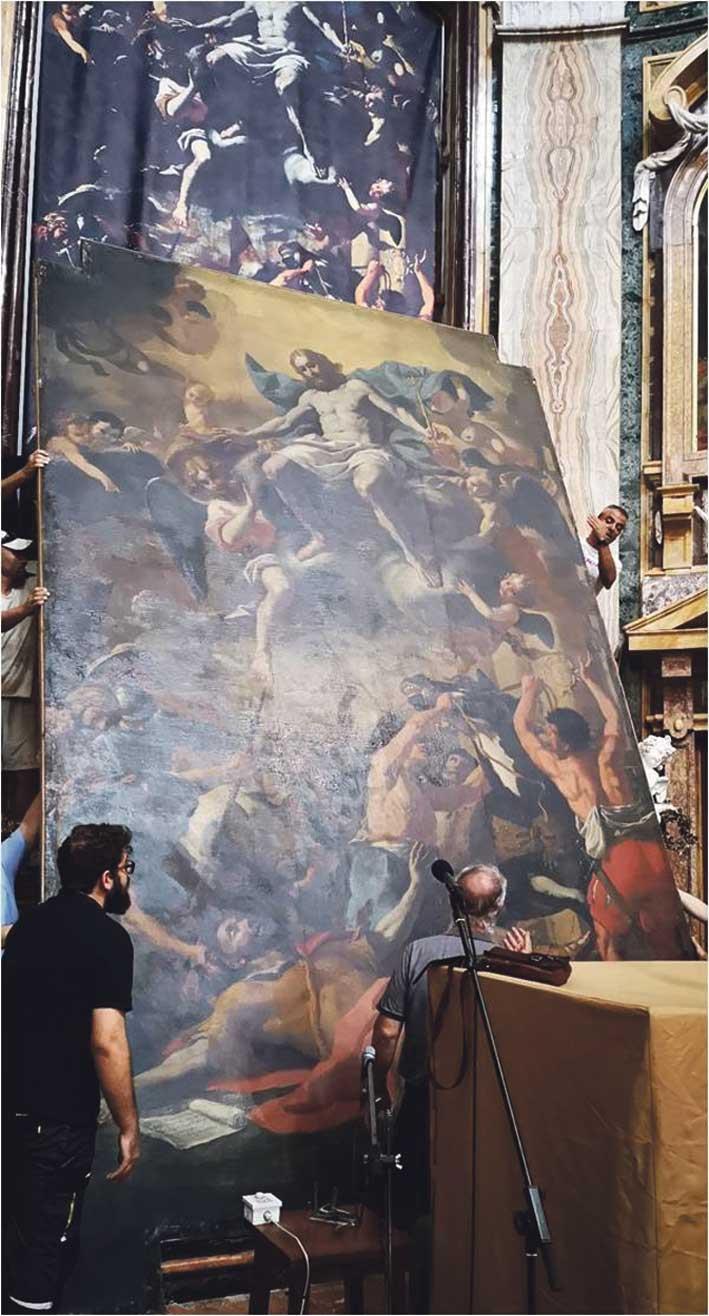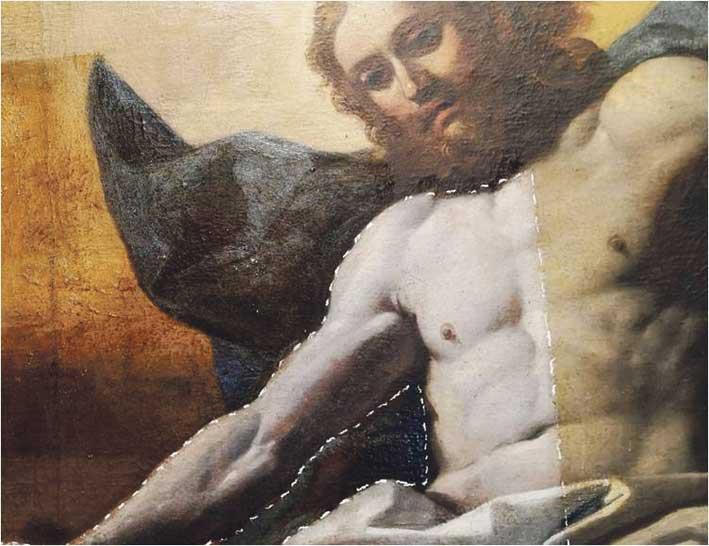On 24 January, eve of the feast of the conversion of St Paul, a precious book was presented to the public in the grand surroundings of the Cathedral of St Paul in Mdina. This book depicts the restoration work carried out by Sante Guido and Giuseppe Mantella on the 15 silver statues known as Apostolato, which were made in Rome by the silversmith Antonio Arrighi between 1739 and 1743 for the altar of the Conventual Church of St John, in Valletta. The volume, which contains various expert studies and is enriched with photos by Daniel Cilia, received the financial support of the Malta Chapter and of Cav. Silvano Pedrollo of Verona, Knight of the Order of St John of Malta. The 15 statues were restored in 2007 with the support of the Vodafone Mata Foundation and HSBC Malta Foundation. They are now exhibited at the Cathedral Museum, Mdina, where they share a space prepared specifically for them and for the Melchiorre Gafà wax models.

On the same evening, the newly-restored titular painting entitled The Conversion of St Paul was also revealed to the public. Author of this grand canvas, which measures 533cm x 310cm, is none other than Mattia Preti, il Cavaliere Calabrese. Preti worked on this masterpiece in 1682 when he was 69 years old and he was commissioned to execute this work for the new presbytery constructed by the Maltese architect Lorenzo Gafà in 1679 under the bishop of Malta, the Catalan Miguel Jeronimo de Molina y Aragonès (1678-1682), member of the Knights of the Order of Malta, whose coat-of-arms appears painted on the column of the right-hand side of the painting. Bishop Molina was not able to see the completed renovation works of the presbytery, because by the time of the consecration of the new altar he had been transferred to the bishopric of Lerida, in Catalunya, in May 1682.

The Conversion of St Paul is part of the series of miracles and mysteries of St Paul on Malta. This was the subject of a major cycle of paintings, executed by Mattia Preti during the last decades of the XVII century and of his life. Mattia Preti was born on 24 February 1613 in the mountain village of Taverna, Calabria.
Preti completed the first three paintings of the Pauline cycle by 28 June 1682, for the feast of St Peter and St Paul. After 1682, he executed another four paintings of extraordinary size for the presbytery lateral walls of the Mdina Cathedral. These represent episodes in the life of St Paul in Malta. The canvas painting on the left-hand side represents the Miracle of the Viper, referring to the famous episode that was to become the defining image of Paul in Maltese art. At the opposite end is the painting of St Paul healing the father of St Publius. On the side wall to the right is the Baptism of Publius, first bishop of Malta converted to Christianity by St Paul. The last one is St Paul liberating Malta from the Moors in 1427. Thanks to the generosity of Monsignor Antonino Testaferrata, the cycle was completed and unveiled on 25 January 1689 by the artist who by then was already past 75 years old.
On 22 March 1688, the Giornale of the Cathedral registered the donation of these seven paintings by Canon Antonino Testaferrata under the Bishop of Malta, the Italian Mons. Davide Cocco Palmieri (1684-1711), member of the Knights of the Order of Malta. The coat-of-arms of Canon Antonino Testaferrata is now clearly visible on all the paintings.
The recently restored titular painting, The Conversion of St Paul is closely connected with the two others paintings which are placed on each side of the high altar at the Cathedral: The Martyrdom of St Peter and The Martyrdom of St Paul. These two paintings were restored by Sante Guido and Giuseppe Mantella in 2013 to commemorate the fourth centenary of the birth of the Cavaliere Calabrese, who especially in his old age, treated the sacred stories with gravity, awe and piety:

With regards to the restoration of this altar piece at Mdina Cathedral, Giuseppe Mantella says that the recent restoration of The Conversion of St Paul showed that it was completely painted single-handedly by the master without the collaboration of any of his assistants. He quotes art historian John Spike as saying, "Towards the end of his life, Preti did not view his canvases as decoration, but as meditation on the deepest mysteries".
After the restoration of the previously mentioned two paintings, six years ago, The Conversion of Saint Paul has now been returned to its previous glory. Mantella stresses how delicate the removal operation of the painting from its position above the main altar was, both because of its dimensions and because it was in a very poor condition owing to many different problems. "Most important was the fact that about 60% of the pictorial film was separating from the supporting canvas with much swelling and the possible loss of colour flakes. In order to preserve every single part of colour in these areas, a protective paper was applied before the start of consolidation. Analysing the edges of the canvas it was clear that years back the painting was enlarged and re-lined."
The original painting, perfectly rectangular, was made by joining together three different canvases of equal size. There are two enlargements: the first one is about 5cm wide with the colours painted directly onto the canvas without the preparatory underlay made of oils, globigerina powder and ochre colour. The second one is dated to the first part of the XVIII century and sees the addition of a new strip of canvas of 50cm in height that follows the profile of the new marble frame. "The whole surface was covered in a thick layer of a very greasy yellow/brown paint that changed all the chromatic relationship."

Art historian Sante Guido states: "Among all Preti's works in Malta, due to the power of their composition, the three Mdina paintings can be compared to three similarly expressive masterpieces that are to be found in the Jesuit Church (Ta' Giesu) in Valletta. These paintings representing Saints Peter and Paul and were painted in 1662. Layers of dirt and candle-smoke obliterate the brightness of the colours which are certainly equal in brilliance to the colours which emerged during restoration of the Conversion of Mdina."
As is normal with a professionally executed restoration, scientific analysis was carried out before, during and at completion. Many photos were taken by Joe Borg, who is an expert in this field. "We have also had the collaboration of Prof. Valentina Venuti, University of Messina and Dr Sebastiano D'Amico, University of Malta. Raman spectroscopy was used for identifying the inorganic pigments, ortophotos and a digital model of the painting was also created."
During the cleaning phase, Giuseppe Mantella, Sante Guido and Ilaria Maretta were surprised to discover the original Testaferrata coat-of-arms which had been hidden when the painting underwent a lengthening process. Consolidation was carried out and several gaps were repaired with stucco. Retouching was done and the surface has been given a transparent protective film.
The titular painting, The Conversion of St Paul by Mattia Preti can be admired above the main altar at St Paul's Cathedral in Mdina and, while visiting this important temple, why not admire all the other Mattia Preti works forming part of the Pauline cycle exhibited there?